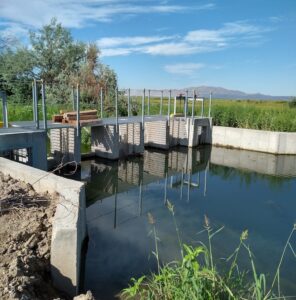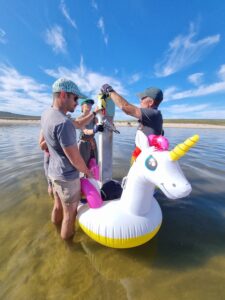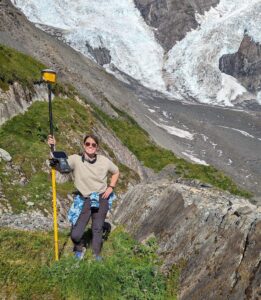The 2024 Environment and Sustainability Research Symposium was held in conjunction with the Wilkes Center for Climate Science & Policy Summit. Students who received research or professional development grants from the GCSC and the Wilkes Center were invited to present on their research. Student presenters are listed along with co-authors below (presenter names are in bold). For this page, rather than providing the scientific abstract, we asked students to describe their research project in layman's terms.
Presenters
Ebenezer Adomako-Mensah, Geology & Geophysics
Estimating Groundwater Inflow to Great Salt Lake
This project is about figuring out how much groundwater is coming into Great Salt Lake (GSL). To do this, we’ve installed monitoring wells along GSL playa to enable us to monitor groundwater flowing into GSL. This will help us understand how much groundwater the lake really gets.
Ja'net Baide, Alexandra Greenwald, Anthropology
Creating Isotope Baselines for Medieval Scandinavia
I am an anthropologist and I study how climate change affected people in the past. To do this, I look at immigration patterns and their associated health outcomes. My research poster describes the first step to reconstructing migration paths for past peoples.
Joey Bai, Atmospheric Sciences
Linking Water Usage & Climate Change to Future Air Quality: Adding a Playa Dust Source to GEOS-Chem
The Great Salt Lake is shrinking and exposing playas that are blowing significant amounts of dust into the air. The dust in the air is unhealthy to breath and affects climate change. Unfortunately, we do not fully understand the extent of which air quality and climate are being affected, but we hope to learn these effects by including the playa dust emissions in models that predict changes to air quality and climate change.
Abby Baka, Anthropology
Exploring the Pleistocene-Holocene Transition Archaeological Record on the Colorado Plateau
In order to find archaeological sites from the end of the last Ice Age (about 12,000 years ago), we used a computer model to predict where sites of this age might be located on the Colorado Plateau. Based on these predictions, we surveyed the landscape on foot to look for archaeological sites. We found three stone spear points that are likely from the last Ice Age.
Suraksha Bhandari, Divya Chandrasekhar, Tasnim Isaba, Donovan Finn, Francis Andre Loquellano, City & Metropolitan Planning
Land Use Based Wildfire Planning for Unincorporated Communities: An Analysis of Community Wildfire Protection Plans in the Western US
The project looked at how different communities plan to protect themselves from wildfires, and we found that many places need better plans. We studied 60 different Community Wildfire Protection plans from 12 states to see what's working and what needs to be improved. We aim to help communities make better plans to protect people and amenities from wildfires.
Kyle G. Brennan, Gabe Bowen, Curry Cunningham, Tim Cline, Geology & Geophysics Decadal Study on Habitat and Production of Pacific Salmon Fisheries using Strontium Isotopes
Imagine we are trying to keep track of where salmon in Alaska travel and how they grow over many years, kind of like keeping a diary for each fish. Salmon are very important for the environment, and for the people who live there, but they face problems like climate change. We use a special method that examines tiny elements inside the ear stones of salmon, which are like little records of where they've been throughout their lives. By studying these records from salmon collected over the last 40 years, we can learn a lot about their travel patterns and how their living environments have changed, helping us protect them better in the future.
Gerardo Carrillo-Cardenas, Gannet Hallar, Sebastian Hoch, Eric Pardyjak, Maria Garcia, William Brown, Zhaoxia Pu, Atmospheric Sciences
Elucidating New Particle Formation in Complex Terrain During the Winter 2022 CFACT Campaign
My project focuses on understanding how different processes within the lower atmosphere, such as turbulence, affects the transport of aerosol particles produced from a process called new particle formation (NPF). New particle formation is known as the spontaneous burst and rapid growth of aerosol particles. My project uses data collected from the CFACT (Cold Fog Amongst Complex Terrain) field campaign to understand and quantify the effects of turbulent mixing within the lower atmosphere on new particle formation and vertical aerosol transport.
Taryn Carvajal Harding, School of Music
"The Female Fugue": The Sound of Moving Towards Gender Equality and Inclusivity
Using information from the fields of psychology and STEM, I composed a piece of music that is aimed at helping others understand experiences lived by others that are different than they are. The composition uses computers, the human voice, and a bass player. The hope with this project is to create a neutral space for expression and understanding.
Brenna Egan, Geography
The Effects of Bioswale Green Infrastructure on Stormwater Quality and Red Butte Creek
Urban stormwater pollutes rivers and streams in cities by introducing large volumes of contaminated water to them quickly during storm events. Green stormwater infrastructure can prevent this by reducing the amount of stormwater that flows into streams and by filtering out pollutants such as trace metals, nutrients, and salts. This study investigated how effective a new green stormwater infrastructure facility on the University of Utah campus is at reducing stormwater volume and contamination.
Alex Farley, Hollis Belnap, Masood Parvania, Electrical and Computer Engineering
Public Investment Strategies to Reduce Household Energy Burdens
As renewable energy becomes more common, low-income households may experience greater energy costs. This work provides a method to equitably reduce energy costs for households in the greatest need. The framework was tested with data from a community in Salt Lake County, UT.
Skylar Fetter, Environmental Humanities
Disturbances: Cultural Stratification and Contamination on the Grasse River
The Grasse River of Akwesasne was contaminated by aluminum manufacturer Alcoa (now Arconic) for decades in the first half of the 20th century. The contamination included harmful carcinogens known as Polychlorinated Biphenyls (PCBs), which pose a serious risk to human and environmental health. In the cleanup process, Environmental Protection Agency (EPA) installed a capping method, layers of clean topsoil and stones, over the main channel sediments in the river, where a majority of these PCBs collect. Community members in the Mohawk community of Akwesasne and the federally recognized St. Regis Mohawk Tribe were against this remedy, citing concerns that it did not go far enough to protect the cultural and ecological importance of the river. When the cap was damaged by ice scraping across the cap in March of 2022, the community's fears were realized, and it was once again revealed that this cleanup method did not meet community standards of protective and long-term remediation or restoration.
Matthew Green, History
Skiing for Fun When Life Was Nasty, Brutish and Short
Some people really like going deep into wild nature and getting as far away from cities and culture as they can. I am interested in finding out more about a particular group of these people, backcountry skiers, who choose to climb snowy mountains in wild places before skiing down them. A big part of my investigation is related to the historical choices people have made about how to have fun in their free time. For example, why do many Americans mostly decide to play it safe by gathering together at sporting events or concerts, while backcountry skiers think it is fun to head way “out of bounds” into wild and dangerous mountain playgrounds?
Sanchaita Hazra, Bodhisattwa Prasad Majumder, Haimanti Bhattacharya, Subhasish Dugar, Economics
Enhancing Socio-economic Sustainability with Human-AI Collaboration
We did an experiment to see if people can tell when a text contains lies, using conversations from a TV game show. We found that people are not good at guessing when it comes to spotting lies. To help mitigate this problem, we paired people with responses from an artificial intelligence (AI) system. We study if knowing how good an AI system is at spotting lies changes how much people trust it. When the AI system was really good, people trusted it the same whether they knew it was good or not. But when the AI wasn’t very good, people trusted it more if they didn’t know its actual ability. This shows that not telling people about an AI’s true skill might lead to more false beliefs and cause social tensions.
Nicolas Hernandez, Communication
Emerging Engagements with Energy Democracy: Rhetoric of Puerto Rican Energy Transition
Puerto Rico is in dire need to upgrade its energy grid. Solar systems with batteries seem to be an ideal solution. However, it is important to pay attention to how energy technologies affect society beyond their ability to produce energy. To find out more about this, I visited Puerto Rico over five years and conducted interviews to find out how people working on energy issues make sense of changing the grid
Seth Jackson, Rand Kingsford, Garrett Collins, Connor Bischak, Chemistry
Conjugated Polymers for Green Energy Solutions
This project looks into how environmentally friendly materials, such as these conjugated polymers, can be used for various energy applications instead of rare metals. I am investigating how changing the ratio of two polymer systems can improve overall performance in water-based electrolytes. Finding the right ratio between a system that shows strong ion transport and a system that shows strong electron transport is important to understand how ions and electrons move in these materials.
Hannah Kalantari, Sabouri S., Brewer S., Ewing R., City & Metropolitan Planning
Machine Learning in Mode Choice Prediction as Part of MPOs’ Regional Travel Demand Models: Is It Time for Change?
This project aims to improve how cities plan transportation by studying why people choose different ways to travel, like driving, walking, or taking the bus. We looked at lots of trips taken by families in different parts of the US and used a special computer program to predict how people decide which mode of transportation to use. Our research found that things like how long a trip takes and whether a family owns a car play a big role in how people choose to travel. This information can help cities make better decisions about things like building roads, sidewalks, and bus routes.
Hayley Kievman, Gregory Burns, Alexandra Greenwald, Anthropology
Re-evaluating the dietary significance of Gambel Oak acorns (Quercus gambelii) in the Great Basin, Colorado Plateau, and Southwest: Evidence from experimental foraging and direct bomb calorimetry
Acorns were and continue to be an important food source for Indigenous groups across North America, however they are rarely found in archaeological sites in the Great Basin, Colorado Plateau, and Southwest. This paper explores the potential reasons for the lack of archaeological evidence of acorn foraging in these three regions.
Junsik Kim, Reid Ewing, Alessandro Rigolon, and Andy Hong, City & Metropolitan Planning
Does Urban Morphology Affect Cardiovascular Disease via Extreme Heat and Air Pollution?
Extreme heat and air pollution can directly increase heart disease. Compact urban form can decrease heart disease directly and indirectly by reducing extreme heat. Also, building complexity can reduce air pollution, and tree canopy can reduce temperature directly and heart disease indirectly. Last, differences in built and environmental conditions by race and ethnicity can lead to inequity in climate conditions and heart disease.
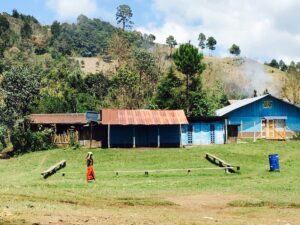 Joaquin Lopez-Huertas, City & Metropolitan Planning
Joaquin Lopez-Huertas, City & Metropolitan Planning
Finding Decolonial Cracks in Planning: Between Navajo and Ixil Re-existences
This research helps to understand how Indigenous Peoples see their relationships with Land and plan for their future despite the legacy of colonization.
Pheej Lauj (Pheng Lor), Environmental Humanities
Evaluation’s Role in Progressing Transdisciplinary & International Socio-Environmental Collaboration
Oceans connect ecosystems, societies, people, and resources. As research from universities grow and evolve to engage community members and the public -- are they doing it effectively? What do these collaborative processes look like to make sure that those who have less knowledge of science and global ecosystems, such as oceans, are a part of the picture?
Tristalee Mangin1, Zachary Palmer2, Zachary Barrett2, Dillon Tang1, Sean Nielson3, Darrah Sleeth2, Kerry Kelly1; 1. University of Utah Chemical Engineering, 2. Rocky Mountain Center for Occupational and Environmental Health, 3. University of Utah Facilities Management, Sustainability & Energy
Effect of Poor Outdoor Air Quality on Indoor Air Quality on the University of Utah Campus
Low-cost air quality sensors can be used to screen for poor indoor air quality (IAQ), and over our one-year study, we identified wildfire smoke events as the greatest outdoor cause of poor IAQ on our campus.
Esther Mathieu, Environmental Humanities
Mad Mud and Strange Survival: A Meeting in the Undefined
The parallels between states of madness, more commonly called mental illness, and wetland ecologies, can teach us new ways of protecting and supporting both people and ecosystems. Learning about each informs the other, and allows us to think about new ways of responding to climate crisis. The project's final form is that of an artist book, whose various components serve as a physical space for the interactions between madness and wetlands to play out.
Molly McCreary, Jeff Moore, Erin Jensen, Valentin Gischig, Geology & Geophysics
Repeated seismicity conditions paraglacial valleys for slope failure in Prince William Sound, Alaska
On the coast of Alaska, there are three large landslides above the glacier in Serpentine Valley. This region is very seismically active and the largest earthquake in North America (M9.2, 1964) occurred only ~100 km away. Over the past 20,000 years, the glacier height in the valley has fluctuated between 250 to 1000 m. We think the change in height of the glacier either protects the valley slope from earthquake damage while glaciers are high, or leaves the slope susceptible to damage at low glacier levels. Understanding how repeated earthquakes interact with valleys with glaciers present can help us understand how slopes can be conditioned to fail during present day ice retreat.
Ishmael Medina, Kenneth Vernon, Jerry Spangler, and Brian Codding, Anthropology
Reconstructing Utah’s Indigenous Maize Farming Niche
We have built the first model to reconstruct the ancestral Indigenous corn niche of Utah (ca. 3200 - 500 years ago). We can do this by using dated corn from the archaeological record to indicate where people would have liked to grow corn. Since the corn is dated, we can look at how settlement patterns change over time.
Stella Mosher, Mitchell J. Power, J. Tyler Faith, Geography
Long-term perspectives on climate, vegetation, and fire in South Africa’s Cape Floristic Region
My research is about how climate change and humans have shaped the long-term history of fire activity in South Africa's Cape Floristic Region. The Cape Floristic Region (surrounding Cape Town) is a biodiversity hotspot of global importance, with over 9,000 plant species in an area about the size of Maine. Many of these plants are fire-adapted and require fire at regular intervals to be healthy. I use lake sediments to learn how fire frequency has varied over thousands of years, how climate changes and people have impacted fire activity, and how interactions between climate, vegetation, and fire relate and differ between different sites.
Kaedan O’Brien, Christian A. Tryon, Lilian Ashioya, and J. Tyler Faith, Anthropology
Different migratory and dietary responses to seasonality in Last Glacial Period versus present-day Kenyan large herbivores
Modern African herbivores like antelopes, buffalo, and zebras respond to the seasonal availability of grasses by either diet-switching (for small species with mixed grazing and browsing diets) or migrating (for large grazers). Our goal is to see if this has always been the case. We find that the relationships between diet, diet-switching, migration, and body size are only present in modern mammal communities, and that African herbivores in the Last Glacial Period had very different behaviors.
Baylee Olds, Margaret Wolf, Paul Brooks, Geology & Geophysics
Goldilocks Forests: Maximizing WaterYield for Drought Resilience
A large and variable fraction of the snow that falls each winter can be lost to the atmosphere during snow accumulation, before the melt season begins. Forest management has the potential to maximize water yield while minimizing the water lost to the atmosphere by understanding how forest structure impacts snow accumulation across varying elevations, aspects, and vegetation types. To prepare for drier years, it is important to maximize shaded areas created by east-west forests and minimize south forest edges.
Rexford Osei Owusu, Alessandro Rigolon, City & Metropolitan Planning
Do green gentrification concerns affect mental health and wellbeing?
We wondered if the addition of new green spaces in underserved areas might attract wealthier new residents to formerly low-income communities of color, potentially forcing them to relocate due to increased housing prices. Our survey analysis shows a negative significant association between mental health outcomes and development support, while there is a positive significant association between wellbeing outcomes and development support (describing actions that promote development and outcomes of development, and notions that neighborhood change is inevitable). Homeowners with high mental health outcomes show positive attitudes toward new green space investments, and residents with insecure housing that are already experiencing stress show a positive association with social integration (describing a mixed composition of higher and lower incomes, different races/ethnicities, and mixed housing stock).
Rexford Osei Owusu, Javier Martinez, Nina Schwarz, City & Metropolitan Planning
Supply and demand of ecosystem services of urban green spaces in deprived areas: Perceptions from Kumasi, Ghana
Residents of two deprived urban areas in Kumasi, Ghana enjoy ecosystem services (ES), that is, benefits from urban green spaces. Gaps between perceived supply and demand for some cultural and regulating ES are identified. Residents adapt to low urban green spaces supply due to land scarcity. These findings pose challenges for climate change adaptation through nature-based solutions.
Jessica Reimer, Danya Rumore, and Emily Gaines-Crockett, City & Metropolitan Planning
Conflict just is? Early evidence for adopting a conflict competent approach to environmental planning and policy
Many people perceive conflict to be a problem, yet solving most of today's pressing societal challenges, including those involving the environment, will require engaging with conflict to develop promising ways forward. However, few people know how to find the opportunity in conflict. This research starts to explore how to best teach and train environmental professionals to frame conflict in a positive way, and understand how productive perceptions of conflict influence their approaches to practice and policy development.
Christine Rumsey, Casie Smith, Zac O'Neal, Scott Hynek, Hannah McIlwain, Geology & Geophysics
Identifying abiotic drivers of ecosystems and productivity in terminal lakes of the Great Basin
Many river basins in the western US do not drain to the ocean and instead form internally-drained lakes and wetlands. These ecosystems provide unique and important habitat and food resources for many different kinds of wildlife. This project aims to better understand how much water and what kind of water is needed to ensure these lake and wetland ecosystems are healthy and productive so that they can be sustained into the future.
Sabrina Santos, Luiza Maria T. Aparecido, Meghan Dovick, Becka Downard, Environmental Science PSM
Ecosystem Conditions of the Freeport Engineered Wetland
An engineered wetland is a construction that aims to mimic an un-impacted wetland's ability to filter water. To better understand if a new engineered wetland is considered a healthy wetland, we looked at both vegetation and water at the location. First, we ran lab tests to detect the amount of nutrients and heavy metals in water samples. Secondly, we recorded the types and quantities of plant species to determine the condition of the engineered wetland’s vegetation community.
Maggie Scholle, Environmental Humanities
In the Middle, At the Margins: Resilience, Novelty, and Futurity at Lee Kay Conservation Area
This project explores ecological and social relationships, history, and visions for the future in a place that has been shallow wetlands, agricultural land, a weapons testing ground, a landfill, and now is a conservation area. I spoke with people who use the area today, other people who study and care about it, and did research in state and county archives to learn more about its history of contamination and change. I describe the land as recovering from processes of wastelanding, which is a way that land is extracted from or contaminated that ignores the people, plants, and animals who care about it. The land's history ends up folded into the place: the physical landscape, its social relationships, and the area's ecology both reflect and resist the past contamination and degradation.
Rebecca J. Seegraber, Colin M. Brand, Timothy H. Webster, Anthropology
Genomic signatures of male reproductive skew in chimpanzees and bonobos (genus Pan)
In wild primate populations, males generally compete for access to females who are ready to reproduce. Some males are better at excluding other males or attracting females. Chimpanzees and bonobos, two closely related species, are similar in many ways, but there are key differences in behavior that lead us to expect high-ranking male chimpanzees to have a greater proportion of offspring than male bonobos. We use variation in DNA sequences to examine this difference.
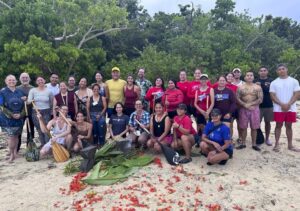 Joaquin Torre, Communication
Joaquin Torre, Communication
Indigenizing Environmental Justice through Language Immersion
Over the summer, I attended a language camp for CHamorus, or, the Indigenous people of Guåhan (Guam). Through my research and interviews with camp members, I argue learning the CHamoru language made campers care more about the environment and see themselves as deeply connected to the world. Therefore, supporting Indigenous peoples and their languages are important for environmental causes.
Natalie Winward, Andrea Brunelle, Jesse Morris, Simon Brewer, Stacy Morris, Justin DeRose, Mitchell Power, Geography
Paleoecology as a tool for land management
Aspen trees are an important tree species that need to be protected. Aspens are important because they reduce the intensity of wildfires. Aspen trees also increase the productivity of ecosystems, and help forests recover from wildfires.
Anahi Yerman, Shane Macfarlan, Connor Davis, Anthropology
From Dry to Deluge: Unexpected Dynamics of Livestock Sales in Ranching Communities
Hurricanes effect about 560 million people per year and have largely been seen as a negative event due to the harms they cause. However, in communities which experience drought hurricanes may change the environment in a way which is seen as positive and can then change how people act. Here we examine how ranchers view hurricane Kay which ended an extreme drought and how the change in their environment effects their sales of cattle and goats.
Qicheng Zeng, Kuan-Fu Feng, and Fan-Chi Lin, Geology & Geophysics
Investigating the relationship between hydrological factors and subsurface seismic velocity changes around Salt Lake Valley
We deployed a temporary seismic network around Salt Lake Valley to better understand if subsurface groundwater storage and soil moisture could potentially be constrained by novel seismic observations. We put out coffee-can-size instruments to record the vibrations of the ground and estimate the speed of subsurface seismic waves over time. We show that the speed of seismic waves could be affected by hydrological factors such as rain falls where more water in the subsurface tends to reduce the speed of seismic waves.
Shuying Zhao, Jessica Haskins, Atmospheric Sciences
Improving Continental Chlorine Sources in GEOS-Chem: Developing a Road-Salt Emissions Inventory
Chlorine radicals affect air quality and climate, even though they're found in small amounts in the air. Most chlorine radicals come from sea salt in the air, but there's evidence that road salt used to maintain road safety in winter might also be a big source to explain underestimated inland chlorine radicals concentrations. We are planning to add this road salt source to a model to see their contribution to chlorine radicals sources and its impact

